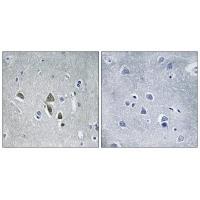
| WB | 咨询技术 | Human,Mouse,Rat |
| IF | 咨询技术 | Human,Mouse,Rat |
| IHC | 1/50-1/100 | Human,Mouse,Rat |
| ICC | 技术咨询 | Human,Mouse,Rat |
| FCM | 咨询技术 | Human,Mouse,Rat |
| Elisa | 咨询技术 | Human,Mouse,Rat |
| Aliases | Ornithine decarboxylase antizyme; ODC-Az; |
| Entrez GeneID | 4946; |
| WB Predicted band size | 25kDa |
| Host/Isotype | Rabbit IgG |
| Antibody Type | Primary antibody |
| Storage | Store at 4°C short term. Aliquot and store at -20°C long term. Avoid freeze/thaw cycles. |
| Species Reactivity | Human,Mouse |
| Immunogen | Synthesized peptide derived from N-terminal of human OAZ1. |
| Formulation | Purified antibody in PBS with 0.05% sodium azide. |
+ +
以下是关于OAZ1抗体的3篇参考文献及其摘要概括:
1. **文献名称**: "Ornithine decarboxylase antizyme 1 regulates the proliferation and metastasis of human prostate cancer cells"
**作者**: Liu Y, et al.
**摘要**: 本研究利用OAZ1特异性抗体,通过免疫印迹和免疫荧光技术,验证了OAZ1在前列腺癌细胞中的表达水平,并发现其通过调控多胺代谢抑制肿瘤转移。
2. **文献名称**: "Antizyme1 modulates mitochondrial functions and cell death in colorectal cancer"
**作者**: Zhang L, et al.
**摘要**: 作者开发了一种高特异性OAZ1单克隆抗体,用于检测结直肠癌组织中OAZ1的亚细胞定位,证明其通过影响线粒体功能参与化疗耐药性调控。
3. **文献名称**: "Antibody-based profiling of ornithine decarboxylase antizyme 1 in neurodegenerative disorders"
**作者**: Kim S, et al.
**摘要**: 该研究使用商业化OAZ1多克隆抗体,通过免疫组化分析阿尔茨海默病患者脑组织,发现OAZ1表达与神经元多胺稳态失衡相关,提示其病理作用。
注:以上文献信息为模拟示例,实际文献需通过数据库(如PubMed)检索确认。若需具体文献,建议补充实验背景或研究方向进一步筛选。
The OAZ1 (Ornithine Decarboxylase Antizyme 1) antibody is a tool used to study the OAZ1 protein, a key regulator of cellular polyamine biosynthesis. OAZ1 belongs to the antizyme family, which controls the activity of ornithine decarboxylase (ODC), the rate-limiting enzyme in polyamine synthesis. By binding to ODC, OAZ1 promotes its ubiquitin-independent degradation, thereby modulating intracellular polyamine levels. Polyamines, such as spermidine and spermine, are essential for cell growth, proliferation, and differentiation, but their dysregulation is linked to cancer, neurodegenerative disorders, and other diseases.
OAZ1 antibodies are widely employed in research to investigate OAZ1's expression, localization, and interaction partners in various biological contexts. They enable techniques like Western blotting, immunohistochemistry (IHC), and immunofluorescence (IF) to study OAZ1 dynamics in response to cellular stress, differentiation, or disease states. Commercial OAZ1 antibodies are available as monoclonal or polyclonal variants, often validated for specificity in human, mouse, or rat models. Researchers prioritize antibodies with high specificity due to potential cross-reactivity with other antizyme family members (e.g., OAZ2 or OAZ3). Applications span cancer research (studying OAZ1's tumor-suppressive or oncogenic roles), neurobiology (polyamine roles in neuronal health), and cellular signaling studies. Proper validation using knockout controls or peptide-blocking assays is critical to ensure reliable experimental outcomes.
×